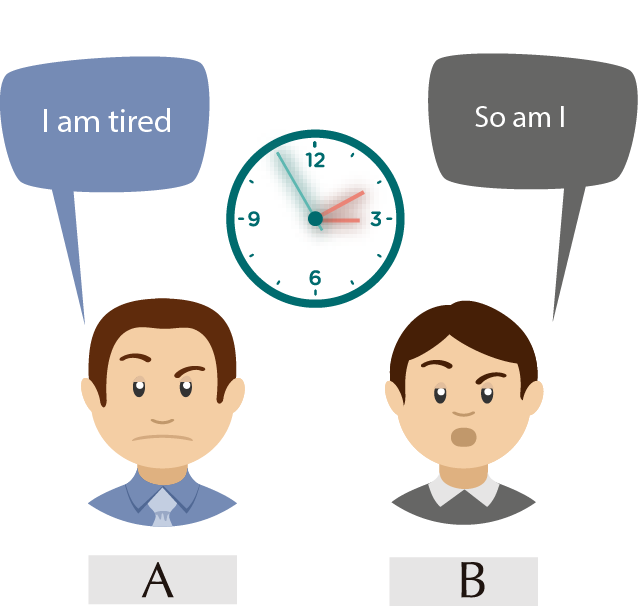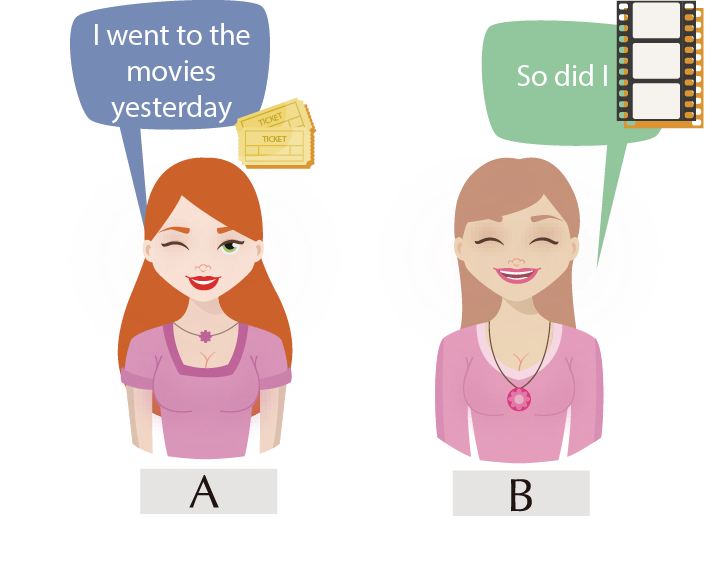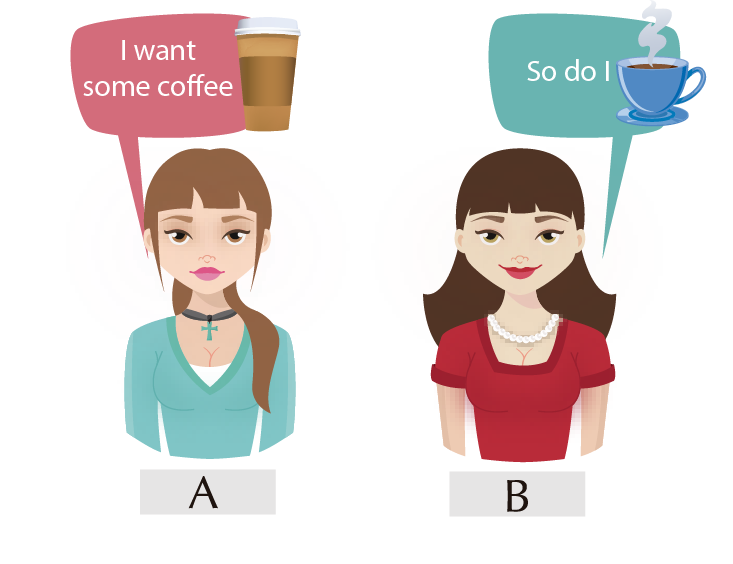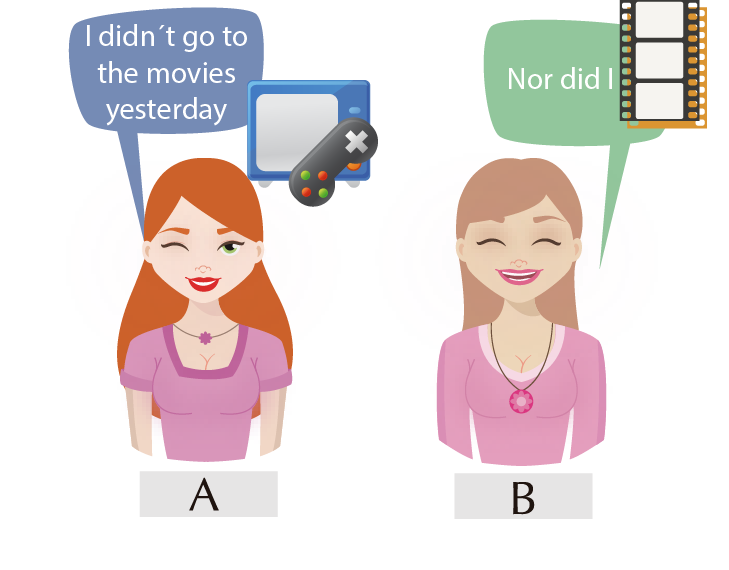It is advantageous to know how to agree in an everyday conversation. If you are talking with somebody and you want to agree, you can use some expressions like ‘so do I’ and ‘neither do I’.
Through this unit, you will be able to learn and practice how to use these common expressions in conversational English.
You will also be able to practice them within the four skills: listening, reading, speaking and writing. You will listen to some conversations to see how to use the agreement expressions in a specific context.
Next, you will practice their use doing some exercises and then record a short conversation to be graded by your tutor. Finally, you will be able to evaluate yourself and see whether you have to review some of the information.

By the end of this topic, you will:
Communicate through the use of phrases "So do I / Neither Do I" during daily activities to express agreement or disagreement.
There will always be the moment when we need to agree or disagree with someone in a conversation. In English, we use “so do I” to agree with positive statements, and “neither do I” to express agreement with negative statements. Here you have two examples:
I love dancing |
"So do I" |
|
I don't like to do exercise |
Neither do I. |


I'm happy |
So am I |
|
I have a dog |
So do I |
I'm going to the beach this summer |
So am I |
I was tired yesterday |
So was I |
|
I went to the movies yesterday |
So did I |
I will buy a new cell phone |
So will I |
I have finished my homework |
So have I |
I would like to learn Japanese |
So would I |
|
I can speak English |
So can I |
|
I should study harder |
So shoud I |
I'm not a teacher |
Neither am I |
|
I don't speak Chinese |
Neither do I |
I'm not going shopping today |
Neither am I. |
I wasn't at home yesterday |
Neither was I |
|
I didn't go to the movies yesterday |
Neither did I |
I won't be able to go to the party |
Neither will I |
I haven't finished my homework |
Neither have I |
I wouldn't like to live in Alaska |
Neither would I |
|
I can't speak Chinese |
"Neither can I" |
|
I shouldn't get late |
Neither should I |
Me too / Me neither
In informal speaking people use “Me too” to agree with a positive statement or “Me neither” to agree with a negative statement. For example:
We can use “Me too” or “Me neither” in response to statements in any tense; present, past , future, present continuous, present perfect, past perfect, etc. For example:
Nor do I / I don’t either / Me neither
Other ways to say ‘Neither do I’ are: ‘Nor do I’ and ‘I don’t either’.
 |
||||
 |
||||
 |
Pronunciation
Neither and either can be pronounced in two ways. Both are correct. You can use either one.
Optional Activity
Here you have a video on the two ways of pronouncing Neither / Either

In an everyday conversation it can happen that we don't agree with somebody. Sometimes we need to express disagreement. We can express disagreement with a positive statement or with a negative statement.
To disagree with a positive statement we use:

"I like coffee without sugar" |
I don't |
To disagree with a negative statement we use:

"I don't like coffee with sugar" |
I do |
Optional Activity
You can see this video with a grammatical explanation of the use of these expressions. It can be useful for you.


Activity 1
You have seen the structure of the statements to agree. Now, in this exercise, you are going to practice how to agree with positive and negative statements in different tenses:

Activity 2
In this activity, you are going to match the statements with the short answers per the situation:
Drag the different elements from the left column to the appropriate space in the right column. You have two attempts to answer every item. You can know your score at the end of the exercise.

Activity 3
You are sharing and giving opinions about regular topics, including the use of affirmative or negative forms.
Click to listen to the conversation:
After listening to the conversation answer the following questions. You can choose more than one name.

Activity 4
Now, you are going to listen to a song where you will hear the expression “So do I”. We hope you enjoy the song:
Click to listen to the conversation:
Afterwards, drag the different options to the appropriate spaces to complete the sentences. You have two attempts to answer the exercise. You can know your score at the end.

Aditional activity
In this video, you can listen to a short dialogue and see a grammatical explanation about the expressions So / Neither / Either / Too

Learn English with Papa Teach Me. (2015, 25, julio). English Grammar - So / Neither / Either / Too. [Archivo de video]. Tomado de: https://www.youtube.com/watch?v=jOh9Fo8tH_U

Activity 5
In this activity, you will practice how to agree or disagree with someone. Also, you will explain your own opinion and add the necessary punctuation.
Reorder the scrambled sentences to form an opinion so you can write the idea in the space provided.
Write your response to each opinion using the expressions to agree or disagree, then try to explain your answers when you respond to each opinion.
Example:
Opinion: I think summer is the best season.
Response: So do I, I love the warm weather and the raining.
Order the words to give an opinion and then write the appropriate response.
Once you have finished writing your phrases, take a look at your development through the next rubric so you can identify your mistakes.

Activity 6
In this activity, you are going to practice agreeing and disagreeing, so, complete the sentences below with information that is true for you.
Then, do a conversation agreeing and disagreeing with an imaginary friend.
Record the conversation, but remember how to agree to a positive sentence.



Remember how to express agreement to a negative sentence:
Examples:
| A: | |||
| A: | ": I don´t want to drink coffee." | B: |
Remember, to express disagreement we use:

If the auxiliary verb is positive in the statement, make the reply negative to disagree. If it’s negative, make the reply positive.



Here is an example of how you can do your conversation:
Complete the sentences with information that is true for you:

Use the next link so you can record yourself through a web page. There will be a resulting file so you can upload it and listen to it.
Once you have finished recording your phrases, take a look at your development through the next rubric so you can identify your mistakes.
Sometimes, fairy tales resulted from the hardships lived in specific periods in history. Such is the case of Hans Christian Andersen’s “The Little Match Girl”. This touching story makes us re-evaluate our lives as well as those things we cherish most.
Read the following extract of this fairy tale. Fill in the gaps with the past perfect simple of the verbs in the box below.
• Seonaid. (s/f). Perfect English Grammar. [blog] Recuperado de: http://www.perfect-english-grammar.com/support-files/so_too_neither_either.pdf
• Grammar Bank. (2011-2016). So / Neither (Nor) / Either / Too. Estados Unidos, California. Recuperado de: http://www.grammarbank.com/so-neither-either-too.html
• Espresso English LLC. (2017). So / Neither / Too – How To Agree In English. Estados Unidos. Recuperado de: https://www.espressoenglish.net/so-neither-too-how-to-agree-in-english/
• Learn English Today. (2003-2015). So – Neither. Francia. Recuperado de: http://www.learn-english-today.com/lessons/lesson_contents/grammar/so_neither.html
• EC English Language Centres. (2017). So and Neither. Malta. Recuperado de: http://www.ecenglish.com/learnenglish/lessons/so-and-neither
• English Current. (2011). English Grammar: How to use too / either / neither. Vancouver, Canada. Sitio: http://www.englishcurrent.com/grammar/grammar-either-neither-too/
• Learn Engish with Valen. Basic English Lessons with Valen ESL. (2009, 18, julio). English Grammar - So & Neither. Sitio: https://www.youtube.com/watch?v=yMZVaLcVAiQ
• Laurent Camus. (s/f). So / neither. Francia. Sitio: http://www.tolearnenglish.com/exercises/exercise-english-2/exercise-english-49198.php
• La Web del Inglés. (2017). Agreement y disagreement, so do I y neither do I. España. Sitio: http://lawebdelingles.com/nivel-b1/agreement-y-disagreement-so-do-i-y-neither-do-i/